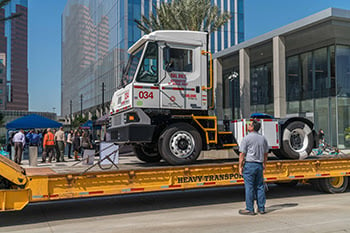
Zero-Emissions equipment deployed to Port Terminals
CARB Grant Helped Fund C-PORT Demonstration Project
In recognition of California Clean Air Day, the Port of Long Beach on Wednesday announced the demonstration of hydrogen- and electric-powered cargo handling equipment at two shipping terminals, in pursuit of its goal to become the world’s first zero-emissions seaport.
The new equipment was purchased through a $5.3 million grant from the California Air Resources Board as part of the “C-PORT,” or Commercialization of POLB Off-Road Technology Project. The Port has several ongoing clean-air technology demonstrations in partnership with labor, marine terminal operators and regulatory agencies.
The CARB grant falls under the umbrella of California Climate Investments, a statewide initiative that puts billions of cap-and-trade dollars to work by reducing greenhouse gas emissions, strengthening the economy and improving public health and the environment – particularly in disadvantaged communities similar to those adjacent to the Port.
“Today, you see some of the equipment with the potential to take us to the next level – zero emissions,” said Long Beach Harbor Commission President Bonnie Lowenthal. “The equipment, which will be operated by our longshore partners at the Port, will help us reduce our impact on our neighborhoods and contribute to the Port’s ability to increase trade.”
Five vehicles will be demonstrated as part of C-PORT: two battery-electric top handlers at SSA Marine’s Pacific Container Terminal at Pier J; and one fuel cell yard tractor, one battery-electric top handler and one battery-electric yard tractor at Long Beach Container Terminal at Pier E.
As part of the project, information about the demonstration was recently integrated into the coursework at the Port-sponsored Academy of Global Logistics at Cabrillo High School to support education and workforce development for new port technologies.
“Projects like these are designed to take us down the road to being the world’s first zero-emissions seaport,” said Port of Long Beach Executive Director Mario Cordero. “We have our labor partners of the ILWU, our terminal operators SSA and LBCT, and our regulatory agencies all working together to find the right technologies to reach our zero-emissions goals. With teamwork and cooperation like that, I think we can look forward to many more innovative projects to demonstrate new technologies.”
The Port of Long Beach is one of the world’s premier seaports, a gateway for trans-Pacific trade and trailblazer in goods movement and environmental stewardship. With 175 shipping lines connecting Long Beach to 217 seaports, the Port handles $200 billion in trade annually, supporting 575,000 Southern California jobs.









